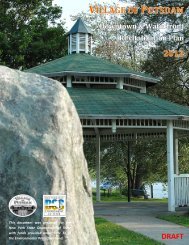Source - Vi.potsdam.ny.us - Potsdam
Source - Vi.potsdam.ny.us - Potsdam
Source - Vi.potsdam.ny.us - Potsdam
You also want an ePaper? Increase the reach of your titles
YUMPU automatically turns print PDFs into web optimized ePapers that Google loves.
AC 150/5325-4B 7/1/2005<br />
locations, small population communities, and remote recreational areas. Their incl<strong>us</strong>ion recognizes that these<br />
airports in ma<strong>ny</strong> cases develop into airports with higher levels of aviation activities.<br />
(2) 100 Percent of Fleet. This type of airport is primarily intended to serve communities<br />
located on the fringe of a metropolitan area or a relatively large population remote from a metropolitan area.<br />
b. Future Airport Expansion Considerations. Airports serving small airplanes remain fairly<br />
constant in terms of the types of small airplane <strong>us</strong>ing the airport and their associated operational requirements.<br />
However, it is recommended that the airport designer assess and verify the airport’s ultimate development plan for<br />
realistic changes that, if overlooked, could result in future operational limitations to c<strong>us</strong>tomers. The airport designer<br />
should at least assess and verify the impacts of:<br />
(1) Expansions to accommodate airplanes of more than 12,500 pounds (5,670 kg). Failure to<br />
consider this change during an initial development phase may lead to the additional expense of reconstructing or<br />
relocating facilities in the future.<br />
(2) Requirements to operate the runway during periods of Instrument Meteorological Conditions<br />
(IMC). The requirement for this capability is highest among airplanes <strong>us</strong>ed for b<strong>us</strong>iness and air taxi purposes.<br />
206. DEVELOPMENT OF THE RUNWAY LENGTH CURVES. 14 Code of Federal Regulations Part 23,<br />
Airworthiness Standards: Normal, Utility, and Acrobatic Category Airplanes, prescribes airworthiness standards for<br />
the issuance of small airplane type certificates. The performance information for each airplane (for example, as<br />
defined in Section 23.51, Takeoff; Section 23.75, Landing; and Section 2.1587, Performance Information) is<br />
contained in the individual airplane flight manual. This information is provided to assist the airplane operator in<br />
determining the runway length necessary to operate safely. Performance information from those manuals was<br />
selectively grouped and <strong>us</strong>ed to develop the runway length curves in figures 2-1 and 2-2. The major parameters<br />
utilized for the development of theses curves were the takeoff and landing distances for figure 2-1 and the takeoff,<br />
landing, and accelerate-stop distances for figure 2-2. The following conditions were <strong>us</strong>ed in developing the curves:<br />
Zero headwind component.<br />
Maximum certificated takeoff and landing weights.<br />
Optimum flap setting for the shortest runway length (normal operation).<br />
Airport elevation and temperature were left variable (values need to be obtained).<br />
Other factors, such as relative humidity and effective runway gradient, also have a variable effect on<br />
runway length but are not accounted for in certification. However, these other factors were accounted for in the<br />
runway length curves by increasing the takeoff or landing distance (whichever was longer) of the group’s most<br />
demanding airplane by 10 percent for the vario<strong>us</strong> combinations of elevation and temperature.<br />
14 Code of Federal Regulations Part 135, Operating Requirements: Commuter and On Demand Operations<br />
and Rules Governing Persons on Board such Aircraft, imposes the operational requirements on those airplanes<br />
having a seating configuration of 10 passenger seats or more to include the accelerate-stop distance parameter in<br />
computing the required takeoff runway length. As previo<strong>us</strong>ly mentioned, figure 2-2 includes the accelerate-stop<br />
distance parameter.<br />
6



